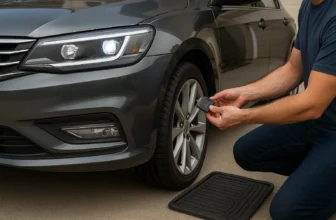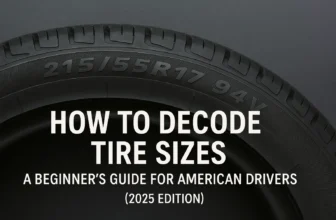Summer is road trip season in the United States — but it’s also one of the most dangerous times to drive. Rising temperatures put added stress on your vehicle, increase the risk of blowouts and breakdowns, and can seriously affect your focus and fatigue levels.
In 2025, with more Americans planning local travel and interstate vacations, staying prepared on the road is more important than ever. A few proactive steps before and during your trip can help prevent accidents, avoid costly repairs, and keep you and your passengers safe.
This guide walks you through the most important summer driving tips — from tire safety to cabin comfort — to help you enjoy the open road without unwanted surprises.
Check Your Tires Before Summer Road Trips
Your tires are your only contact with the road — and they take a beating in summer heat. As temperatures rise, so does the air pressure inside your tires. But overinflation can be just as dangerous as underinflation, especially at highway speeds.
What to Do:
- Check tire pressure when tires are cold, preferably in the morning. Use the PSI recommended on your driver’s side door label.
- Inspect for wear and damage — look for cracks, bulges, or uneven tread.
- Rotate your tires if it’s been more than 6,000 miles. It promotes even wear and extends life.
- Don’t forget the spare — make sure it’s properly inflated and accessible.
Tip: If you’re heading out on a long road trip, consider visiting a tire shop for a free inspection. A 15-minute check could save you from a major delay or blowout on the freeway.
Keep Your Engine Cool: Prevent Overheating in Hot Weather
Summer heat can push your engine to its limits, especially if your cooling system isn’t in top shape. Overheating is one of the most common causes of summer breakdowns in the U.S., particularly during long-distance travel or stop-and-go traffic.
How to Prevent It:
- Check coolant levels regularly and top up with a 50/50 mix of antifreeze and water if needed.
- Inspect radiator hoses for leaks, cracks, or swelling — they tend to fail under pressure.
- Monitor your temperature gauge — if it starts creeping up, turn off the AC and switch the heater on to help draw heat away from the engine.
- Listen to your car — grinding noises or steam from under the hood are signs to pull over immediately.
If your car does begin to overheat, pull over safely, turn off the engine, and let it cool before opening the hood. Never remove the radiator cap when the engine is hot — it can cause serious burns.
Air Conditioning and Cabin Comfort: Stay Cool on the Inside
A properly functioning AC system isn’t just about comfort — it’s also critical for safety. High cabin temperatures can cause fatigue, irritability, and even heatstroke during long drives, especially for children and older passengers.
Summer AC Maintenance Checklist:
- Test your air conditioning early, before your first big trip. If it’s blowing weak or warm, get it inspected for leaks or low refrigerant.
- Replace the cabin air filter — a clogged filter reduces airflow and makes the AC work harder.
- Use sunshades or windshield reflectors when parked to lower cabin temperature by 10–20°F.
- Crack windows slightly when parked (if safe) to release built-up hot air.
Bonus Tip: Keep a portable fan, extra water bottles, and light-colored seat covers in your car — small comforts that make a big difference when temperatures hit triple digits.
Emergency Kit Essentials for Summer Driving
Even with perfect planning, things can go wrong — which is why a well-stocked emergency kit is a must for summer travel. In hot weather, dehydration and heat exposure can turn a minor delay into a serious health risk.
What to Pack:
- Water (at least 2–4 liters per person)
- Electrolyte packets or sports drinks
- Portable jump starter or jumper cables
- Tire inflator or sealant kit
- Flashlight with extra batteries
- Sunscreen, hat, and sunglasses
- Cooling towels or spray bottles
- Basic first aid kit
- Phone charger and power bank
- Snacks with long shelf life (like protein bars)
Also, double-check your spare tire, jack, and lug wrench. A flat tire is still one of the most common reasons for roadside calls — don’t be caught unprepared.
Hydration and Driver Fatigue: Staying Alert in Summer Heat
Heat doesn’t just affect your car — it affects you. Long drives in high temperatures increase your risk of dehydration and drowsy driving, both of which can lead to serious accidents. Fatigue is one of the most underestimated dangers on summer road trips.
How to Stay Alert and Hydrated:
- Drink water regularly, even if you don’t feel thirsty. Dehydration sets in faster in a hot vehicle.
- Avoid energy drinks or heavy meals before long drives — they can cause crashes in blood sugar or caffeine crashes later.
- Take breaks every 2 hours on long trips. Stretch, walk, and rest your eyes to prevent highway hypnosis.
- Use cooling towels or vent-mounted fans to reduce body heat on especially long or congested drives.
Listen to your body. If you feel sluggish, irritable, or dizzy — pull over, rest, and rehydrate before continuing. Safety isn’t just about the car; it starts with the driver.
Watch for Summer Storms and Flash Flood Risks
Summer weather can change in minutes. From sudden downpours to flash floods and lightning storms, U.S. roads — especially in the South and Midwest — can become dangerous with little warning.
Driving Safely in Sudden Summer Storms:
- Slow down immediately — wet roads drastically reduce traction.
- Increase following distance and use headlights in low visibility.
- Avoid cruise control on slick or rainy roads; it reduces your control in emergencies.
Flash Flood Warning Tips:
- Never drive through flooded roads, even if the water looks shallow — just 6 inches can disable a vehicle, and 12 inches can carry it away.
- Turn around, don’t drown — always seek an alternate route if flooding is reported.
- Watch for rising water levels on highways, especially in low-lying areas or near underpasses.
Stay informed with a reliable weather app or local radio station, especially when driving in flood-prone regions during storm season.
Protect Your Car’s Exterior and Interior from Sun Damage
Your car’s body and cabin materials take a beating in the sun. Prolonged UV exposure can fade paint, crack dashboards, and deteriorate upholstery — all of which reduce resale value and comfort.
Protection Tips:
- Use a windshield sunshade every time you park outdoors. It lowers cabin temperature and protects your dash.
- Apply UV protectant to your dashboard, door panels, and leather or vinyl seats.
- Wash and wax your car regularly — a good wax layer provides a UV-resistant shield that helps preserve the paint.
- Consider ceramic coating for long-term UV and dirt protection if you live in high-sun areas like Arizona, Texas, or Florida.
A little maintenance now goes a long way in preserving your car’s looks and value through the hottest months.
Drive Smart, Stay Safe, and Enjoy the Summer Road Ahead
Summer driving should be fun — not stressful. By preparing your car and yourself for heat, storms, long distances, and unexpected stops, you dramatically reduce your chances of trouble on the road.
To recap:
- Check your tires and engine cooling system
- Stay hydrated and alert during long drives
- Pack an emergency kit tailored for hot weather
- Be ready for storms and protect your car from UV damage
Whether you’re road-tripping across states or just commuting in the summer sun, these tips will help keep you safe, cool, and confident behind the wheel in 2025.







